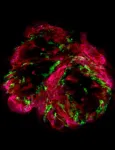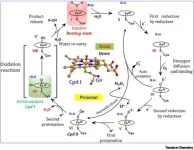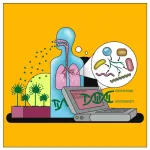(Press-News.org) CAMBRIDGE, MA -- For a small percentage of cancer patients, doctors are unable to determine where their cancer originated. This makes it much more difficult to choose a treatment for those patients, because many cancer drugs are typically developed for specific cancer types.
A new approach developed by researchers at MIT and Dana-Farber Cancer Institute may make it easier to identify the sites of origin for those enigmatic cancers. Using machine learning, the researchers created a computational model that can analyze the sequence of about 400 genes and use that information to predict where a given tumor originated in the body.
Using this model, the researchers showed that they could accurately classify at least 40 percent of tumors of unknown origin with high confidence, in a dataset of about 900 patients. This approach enabled a 2.2-fold increase in the number of patients who could have been eligible for a genomically guided, targeted treatment, based on where their cancer originated.
“That was the most important finding in our paper, that this model could be potentially used to aid treatment decisions, guiding doctors toward personalized treatments for patients with cancers of unknown primary origin,” says Intae Moon, an MIT graduate student in electrical engineering and computer science who is the lead author of the new study.
Alexander Gusev, an associate professor of medicine at Harvard Medical School and Dana-Farber Cancer Institute, is the senior author of the paper, which appears today in Nature Medicine.
Mysterious origins
In 3 to 5 percent of cancer patients, particularly in cases where tumors have metastasized throughout the body, oncologists don’t have an easy way to determine where the cancer originated. These tumors are classified as cancers of unknown primary (CUP).
This lack of knowledge often prevents doctors from being able to give patients “precision” drugs, which are typically approved for specific cancer types where they are known to work. These targeted treatments tend to be more effective and have fewer side effects than treatments that are used for a broad spectrum of cancers, which are commonly prescribed to CUP patients.
“A sizeable number of individuals develop these cancers of unknown primary every year, and because most therapies are approved in a site-specific way, where you have to know the primary site to deploy them, they have very limited treatment options,” Gusev says.
Moon, an affiliate of the Computer Science and Artificial Intelligence Laboratory who is co-advised by Gusev, decided to analyze genetic data that is routinely collected at Dana-Farber to see if it could be used to predict cancer type. The data consist of genetic sequences for about 400 genes that are often mutated in cancer. The researchers trained a machine-learning model on data from nearly 30,000 patients who had been diagnosed with one of 22 known cancer types. That set of data included patients from Memorial Sloan Kettering Cancer Center and Vanderbilt-Ingram Cancer Center, as well as Dana-Farber.
The researchers then tested the resulting model on about 7,000 tumors that it hadn’t seen before, but whose site of origin was known. The model, which the researchers named OncoNPC, was able to predict their origins with about 80 percent accuracy. For tumors with high-confidence predictions, which constituted about 65 percent of the total, its accuracy rose to roughly 95 percent.
After those encouraging results, the researchers used the model to analyze a set of about 900 tumors from patients with CUP, which were all from Dana-Farber. They found that for 40 percent of these tumors, the model was able to make high-confidence predictions.
The researchers then compared the model’s predictions with an analysis of the germline, or inherited, mutations in a subset of tumors with available data, which can reveal whether the patients have a genetic predisposition to develop a particular type of cancer. The researchers found that the model’s predictions were much more likely to match the type of cancer most strongly predicted by the germline mutations than any other type of cancer.
Guiding drug decisions
To further validate the model’s predictions, the researchers compared data on the CUP patients’ survival time with the typical prognosis for the type of cancer that the model predicted. They found that CUP patients who were predicted to have cancer with a poor prognosis, such as pancreatic cancer, showed correspondingly shorter survival times. Meanwhile, CUP patients who were predicted to have cancers that typically have better prognoses, such as neuroendocrine tumors, had longer survival times.
Another indication that the model’s predictions could be useful came from looking at the types of treatments that CUP patients analyzed in the study had received. About 10 percent of these patients had received a targeted treatment, based on their oncologists’ best guess about where their cancer had originated. Among those patients, those who received a treatment consistent with the type of cancer that the model predicted for them fared better than patients who received a treatment typically given for a different type of cancer than what the model predicted for them.
Using this model, the researchers also identified an additional 15 percent of patients (2.2-fold increase) who could have received an existing targeted treatment, if their cancer type had been known. Instead, those patients ended up receiving more general chemotherapy drugs.
“That potentially makes these findings more clinically actionable because we’re not requiring a new drug to be approved. What we’re saying is that this population can now be eligible for precision treatments that already exist,” Gusev says.
The researchers now hope to expand their model to include other types of data, such as pathology images and radiology images, to provide a more comprehensive prediction using multiple data modalities. This would also provide the model with a comprehensive perspective of tumors, enabling it to predict not just the type of tumor and patient outcome, but potentially even the optimal treatment.
###
The research was funded by the National Institutes of Health, the Louis B. Mayer Foundation, the Doris Duke Charitable Foundation, the Phi Beta Psi Sorority, and the Emerson Collective.
END
AI model can help determine where a patient’s cancer arose
Predictions from the OncoNPC model could enable doctors to choose targeted treatments for difficult-to-treat tumors.
2023-08-07
ELSE PRESS RELEASES FROM THIS DATE:
Using social media to raise awareness of women’s resources
2023-08-07
CAMBRIDGE, MA The Covid-19 pandemic created a global increase in domestic violence against women. Now, an MIT-led experiment designed with that fact in mind shows that some forms of social media can increase awareness among women about where to find resources and support for addressing domestic violence.
In the randomized experiment, set in Egypt, women recruited via Facebook were sent videos via social media as well as reminders to watch television programming from a well-known Egyptian human rights lawyer focused on gender norms and violence. The study found that receiving the videos or reminders increased consumption of media content about the issue, increased knowledge ...
Dana-Farber AI-model predicts primary source of cancer using gene sequencing data
2023-08-07
BOSTON – Researchers at Dana-Farber Cancer Institute have created an AI-based tool that uses tumor gene sequencing data to predict the primary source of a patient’s cancer. The study, published in in Nature Medicine, suggests that this predictive tool, called OncoNPC, could help guide treatment of cancer and improve outcomes in difficult to diagnose cases.
The primary source of cancer is traditionally diagnosed by a standardized diagnostic work-up, including radiology and pathology assessments based on slides of cells taken from a tumor biopsy. In 3-5% of cancer ...
Game-changing potential for drug testing and cardiovascular disease treatments - Tiny Heart Model Carries Massive Implications
2023-08-07
A remarkable breakthrough, a collaborative team of researchers, led by Professor Yaakov Nahmias from The Hebrew University of Jerusalem, Technion-Israel Institute of Technology, and Tissue Dynamics Ltd., has unveiled a miniature human heart model that could potentially transform drug testing and cardiovascular research. This study, published in Nature Biomedical Engineering, introduces a self-paced multi-chambered human heart model, no larger than a grain of rice, which promises to revolutionize the way we study the heart and its functions.
Cardiovascular ...
Fanning the flames
2023-08-07
As Canadian wildfire smoke continues to impact large swaths of the United States, resulting in poor air quality and negative health outcomes for millions of Americans, more people than ever are feeling the effects of longer fire seasons and a changing climate. Now, researchers at Washington University in St. Louis have discovered that wildfires may have even bigger climate impacts than previously thought.
In a new study published Aug. 7 in Nature Geoscience, researchers led by Rajan Chakrabarty, the Harold D. Jolley Career Development Associate Professor in the ...
Effective medications for opioid use disorder rarely used
2023-08-07
Most individuals diagnosed with opioid use disorder are not on recommended medications and even fewer remain in care, according to a research letter published today in JAMA Internal Medicine by lead author Ashley Leech, PhD, assistant professor in the Department of Health Policy at Vanderbilt University Medical Center (VUMC).
In 2021, there were more than 100,000 overdose deaths in the United States, with the highest rates among those ages 25-54.
Just 22% of the 40,000 individuals with opioid use disorder studied by VUMC researchers continuously used ...
Discovery in nanomachines within living organisms - cytochromes P450 (CYP450s) unleashed as living soft robots
2023-08-07
[Jerusalem, Israel] Study reveals an important discovery in the realm of nanomachines within living systems. Prof. Sason Shaik from the Hebrew University of Jerusalem and Dr. Kshatresh Dutta Dubey from Shiv Nadar University, conducted molecular-dynamics simulations of Cytochromes P450 (CYP450s) enzymes, revealing that these enzymes exhibit unique soft-robotic properties.
Cytochromes P450 (CYP450s) are enzymes found in living organisms and play a crucial role in various biological processes, particularly in the metabolism of drugs and xenobiotics. The researchers' simulations demonstrated that CYP450s possess a fourth dimension - the ability to sense and respond to ...
Scientists crack the code of what causes diamonds to erupt
2023-08-07
An international team of scientists led by the University of Southampton has discovered that the breakup of tectonic plates is the main driving force behind the generation and eruption of diamond-rich magmas from deep inside the Earth.
Their findings could shape the future of the diamond exploration industry, informing where diamonds are most likely to be found.
Diamonds, which form under great pressures at depth, are hundreds of millions, or even billions, of years old. They are typically found in a type of volcanic rock known as kimberlite. Kimberlites are found in the oldest, thickest, ...
A fungus gets comfortable
2023-08-07
Aspergillus fumigatus strains that infect humans have a significantly altered metabolism compared to other strains in the environment. At the same time, infection with the fungus leads to an apparent change in the human lung microbiome. Researchers at the Leibniz Institute for Natural Product Research and Infection Biology (Leibniz-HKI) in Jena, Germany, came to this conclusion after using machine learning models to analyze genome data from about 250 fungal strains and lung microbiome data from 40 patients.
The fungus Aspergillus fumigatus is widely distributed in the environment, where it performs important ecological functions. ...
CEHD researchers receive funding for project on quantum teaching & learning in elementary classrooms
2023-08-07
Nancy Holincheck, Assistant Professor, Advanced Studies in Teaching and Learning, School of Education; Jessica Rosenberg, Associate Professor, Physics and Astronomy; Stephanie Dodman, Associate Professor, School of Education; and Benjamin Dreyfus, Associate Professor, Physics and Astronomy, received funding from the National Science Foundation for the project: "EAGER: Quantum is Elementary: Quantum Teaching & Learning in Elementary Classrooms."
The researchers will study learning associated with elementary teachers' engagement in professional learning and elementary students' learning related to quantum science, quantum thinking, and careers. The ...
More work needed to unlock mysteries of Asia’s bees
2023-08-07
Although the collapse of hives of European honey bees (Apis mellifera) has gained worldwide attention in recent years, there are massive gaps in knowledge of other bee species, particularly in the Asian region, which contains over half the world’s human population and where food security (in which bees play a key role) remains a major challenge.
According to a recent global analysis, only 1% of the global public data on bee distribution comes from Asia, even though 15% of the world’s bee species are thought to live there.
In a new paper, “Opportunities and challenges in Asian bee research and conservation”, published in the journal ...
LAST 30 PRESS RELEASES:
Common eye ointment can damage glaucoma implants, study warns
ACCESS-AD: a new European initiative to accelerate timely and equitable AD diagnosis, treatment and care
Mercury exposure in northern communities linked to eating waterfowl
New Zealand researchers identify brain link to high blood pressure
New research confirms people with ME/CFS have a consistent faulty cellular structure
Hidden cancer risk behind fatty liver disease targets
Born in brightness, leading to darkness
Boron-containing Z-type and bilayer benzoxene
Hong Kong researchers break the single-field barrier with dual-field assisted diamond cutting
Work hard, play hard?
Wood becomes smart glass: Photo- and electro-chromic membrane switches tint in seconds
The Lancet: COVID-19 vaccine hesitancy decreased over time, though mistrust persists among certain groups, study of over 1 million people in England suggests
Psychosis patients ‘living in metaphor’ -- new study radically shifts ideas about delusions
Clinical trial in Ethiopia targets the trachoma scourge
Open-sourcing the future of food
Changes in genetic structure of yeast lead to disease-causing genomic instabilities
UC San Diego Health Sciences Grant Writing Course helps launch successful research careers
Study: Many head and neck cancer trials end early. Why?
Tufts vice provost for research named Foreign Fellow of Indian National Science Academy
New model improves prediction of prostate cancer death risk
Two wrongs make a right: how two damaging variants can restore health
Overlooked decline in grazing livestock brings risks and opportunities
Using rare sugars to address alcoholism
Research alert: New vulnerability identified in aggressive breast cancer
Ruth Harris honored with SSA Distinguished Service Award
Treasure trove of data on aging publicly accessible
Trees4Adapt project to address risks from climate change and biodiversity loss through tree-based solutions
Nature Communications study from the Lundquist Institute identifies molecular mechanism underlying peripartum cardiomyopathy
Pennington Biomedical’s Dr. Gang Hu appointed to NIH Reproductive, Perinatal and Pediatric Health Review Group
World-first project shows great promise to treat low eye pressure
[Press-News.org] AI model can help determine where a patient’s cancer arosePredictions from the OncoNPC model could enable doctors to choose targeted treatments for difficult-to-treat tumors.






